Logging in
The BQN has a web-based Graphic User Interface (GUI) to perform the most common management tasks. Desktop browsers Chrome, Firefox, Safari and Microsoft Edge are supported (MS Explorer is not).
The GUI has contextual help: press the ? help icon on the page for which help is needed.
Login
To access the GUI, open a browser and visit the URL: https://oam-ip, where oam-ip is the management IP address (192.168.0.121 by default).
The BQN uses a self-signed certificate, and the browser will signal it as unsecure. Ignore the warning and go to the web page.
Enter bqnadm user and the password:

User root cannot be used to log into the GUI.
Initial Dashboard Page

The home page has a lateral menu, a dashboard, and a small summary of system information.
The dashboard must show all icons in green. The Network Interfaces icon will not be green until all the configured wires are connected (if there are interfaces not being used in any of the configured wires, it will remain in orange) and the icon Low Traffic will not be in green until the traffic flows through the BQN. In some icons, clicking on them goes to a window with more information about the BQN status. See below Troubleshooting for steps to take when an icon is not in normal state.
The GUI supports dark mode. You can change between dark and clear mode clicking on the user area in the bottom right corner and changing the Dark Mode switch.
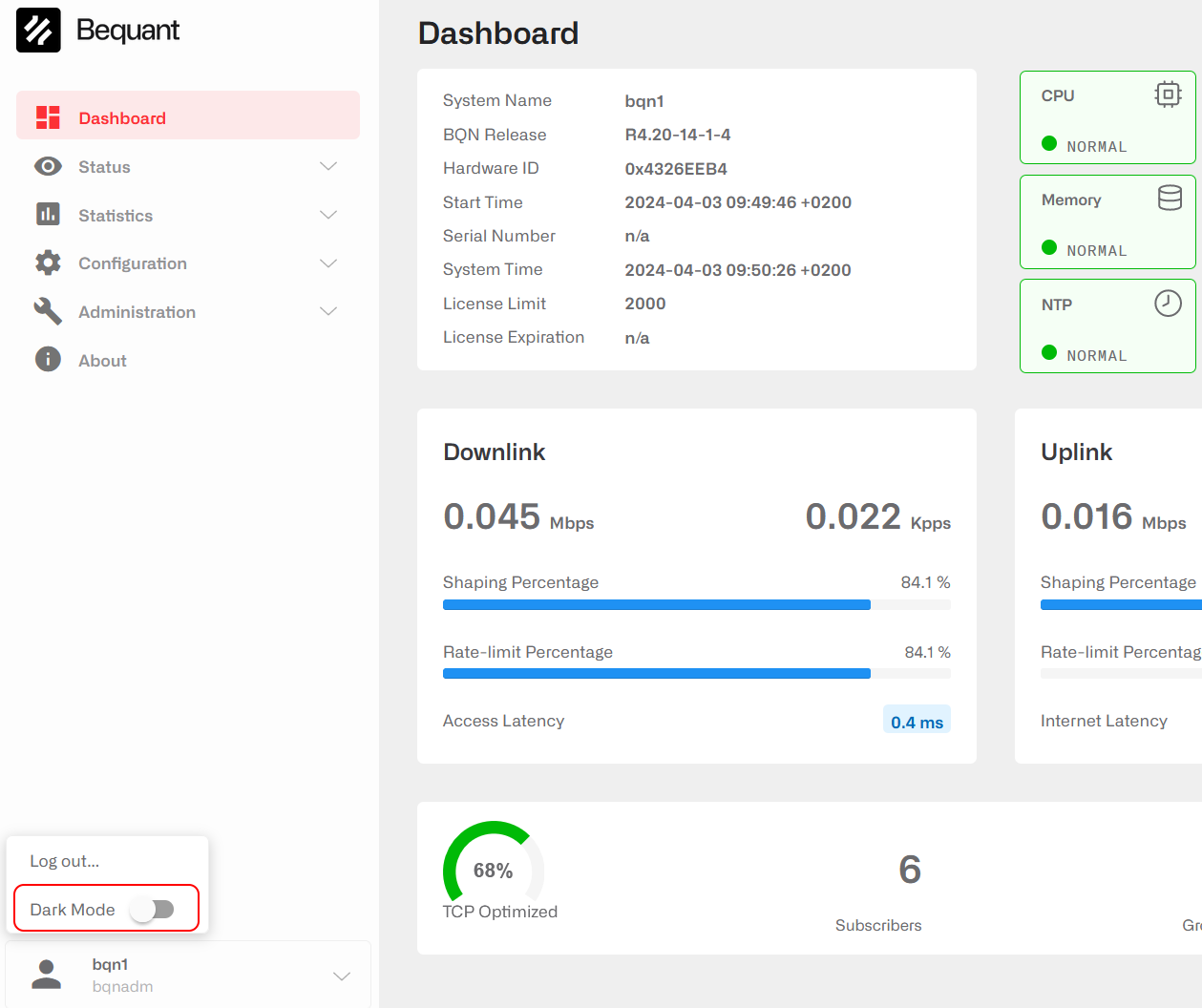
Tables
Many GUI pages contain data tables to display information. The following picture provides an example.
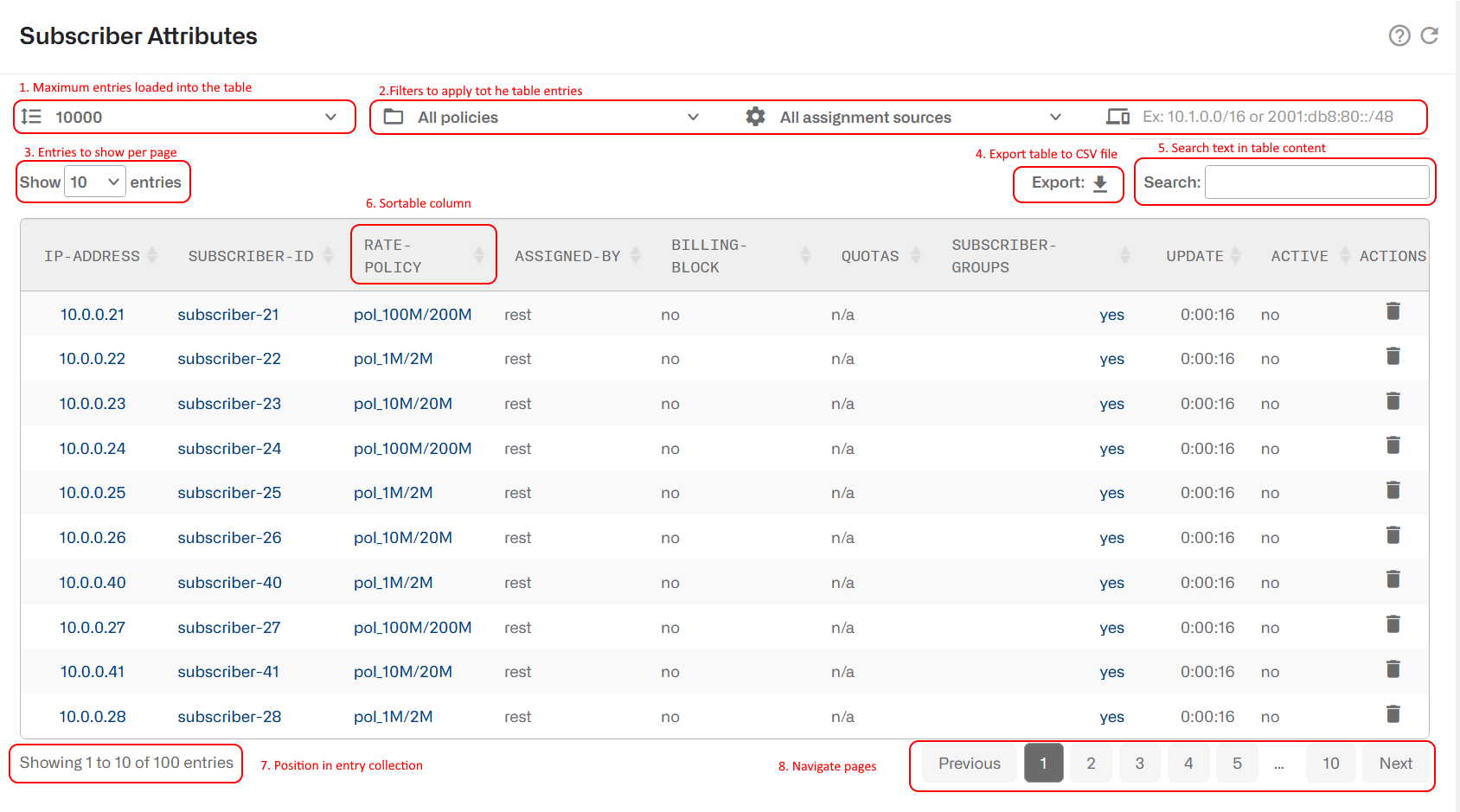
We have highlighted in red the most important features:
- The first selector on the upper left defines how many entries to load in the table (10,000 in the example). The default value of each table is chosen to load all entries in normal circumstances. If the default is too low, a bigger number can be selected here.
- To the right of the total entries, there are several elements to filter the table content. In the example above, entries can be filtered by policy and by subscriber.
- The “show entries” define the page size.
- The Export button generates a CVS file with the table content. The file has a first row with the column labels and then one line per table row.
- The search field shows the table entries containing the substring specified in the text field.
- Columns with arrows are sortable. To sort by a column, click on that column label. Clicking again will use reversed ordering.
- A label on the lower left informs about where we are in the list of entries.
- The buttons on the lower right navigates along the table pages
When exporting tables to CVS, because a comma has special meaning, commands are scaped as follows:
- If a field contains a comma(“,”) the whole field is enclosed in double quotes. For example: a,b is exported as “a,b".
- If a field contains one double quote, it is replaced by two double quotes. For example: a”b is exported as a””b.
- If both a comma and a double quote is present, both rules are applied. For example, “a,b” is exported as “””a,b”””.
Changing the Time
If it is necessary to change the system time, go to Administration->System Date->Set Date & Time.

Apply Date changes the local date and time, and Apply Zone changes the time zone. It is possible to browse through the list of time zones pressing the initials of the country of Interest (e.g., ES for Spain).
Changing the Management IP Address
To change the settings of the management interface, select on the lateral menu Configuration->Interfaces->Management. IP settings include the IP address and mask, the default gateway and the VLAN identifier (if any).
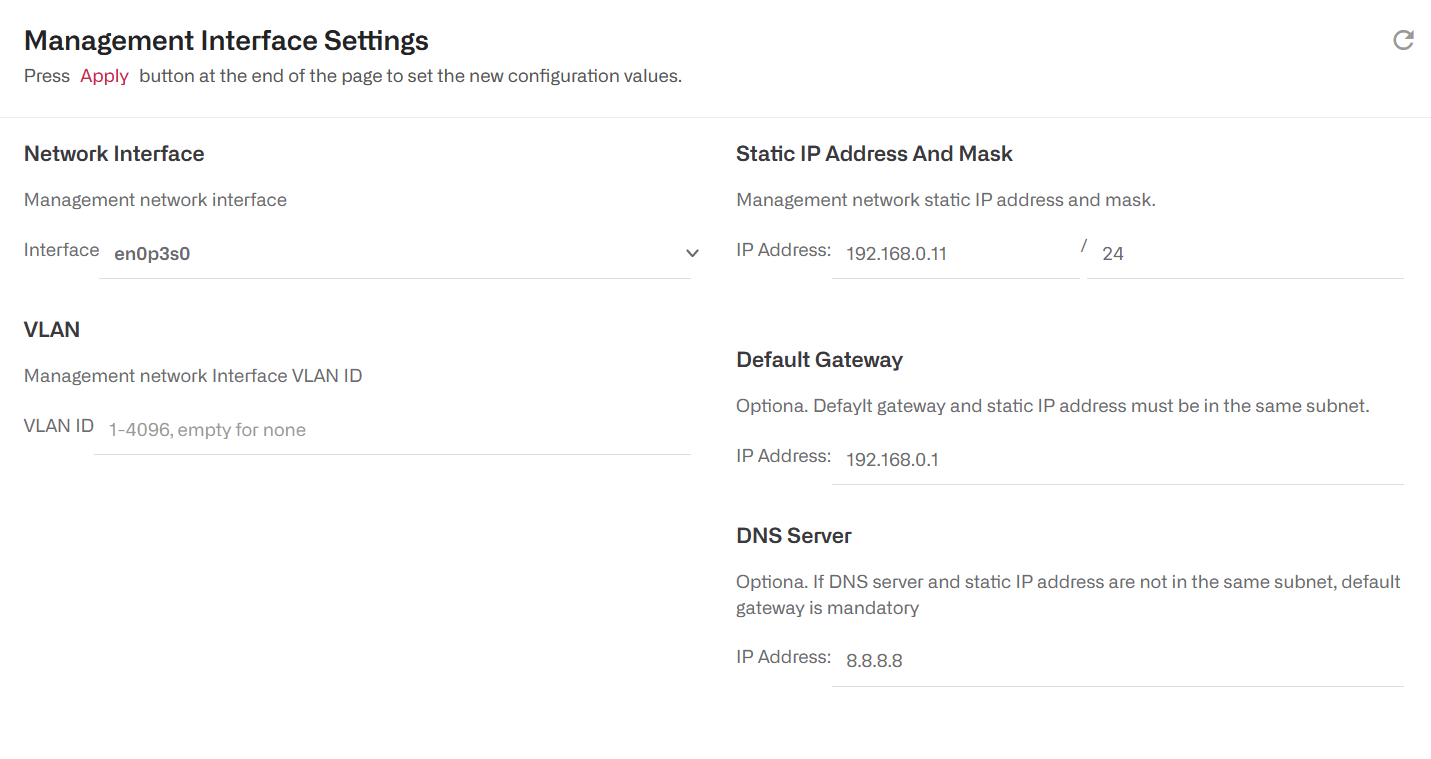
An optional DNS server IP address can be configured (needed if server names are used in the integration with a billing system).
The network Interface used for management must not be changed, unless indicated by the Bequant support personnel.
When the new settings are completed, press Apply Configuration to commit the changes. Connecting back to the node may require access from the new subnet and logging back into the GUI.
Wire Configuration
A wire is a network interface pair processing subscriber traffic.
To configure wires, select Configuration->Interfaces->Data Wires.

Wires are directional, with the first network interface connected to the access towards the subscribers and the second interface on the Internet side. If a mistake has been made in connecting the ports, they can be swapped clicking on the ⇄ arrows icon.
To add a wire, click on the ⁝ menu icon and select Add Wire…. A form will allow you to select the access and Internet interfaces (the form will list the interfaces available). The pcap option is selected only for cards other than Intel (pcap allows compatibility at the price of reducing server performance).
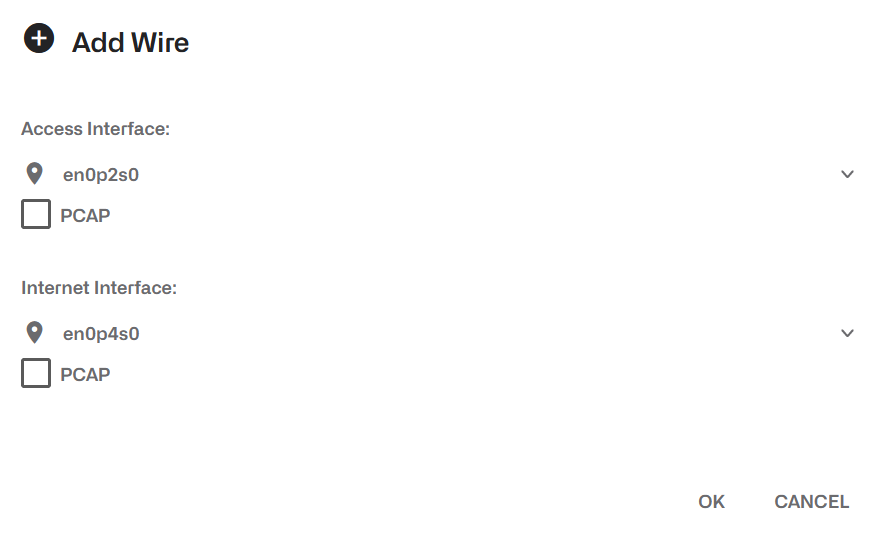
To remove a wire, press the trash can icon. To modify a wire (for example, to enable the pcap option), you have to remove the existing wire and then, before applying the changes, add the wire with the change.
Wires should not be deleted unless indicated by the Bequant support personnel, as misconfigurations may lead to service loss.
Changes only apply after clicking Apply Configuration.
IPMI Configuration
Some servers have a lights-out module for general management (power on/off, hardware monitoring, etc). We recommend using the server own setting tools (e.g. BIOS section), but if this is not possible (e.g. the server is already powered and with traffic), the BQN CLI allows a basic setup.
To do it, access to the BQN shell is needed.The following example sets a static IP address 192.168.0.120/24 with default gateway 192.168.0.1 and creates a new user bequant.
Remote Access using Port Forwarding
To allow access from the Internet to the BQN server in a secure way, a port forwarding rule should be configured, restricted to only a small set of source IP addresses. The rest of the section describes the steps to follow in a Mikrotik router to do port forwarding of HTTPS (port 443). Similar steps can be followed for SSH (port 22).
Go to IP->Firewall->Address Lists and create an address list with all the source IP addresses that will be allowed access to the BQN server (in our example, we call it bqn-allowed-src).
In IP->Firewall->NAT, create a destination NAT rule:
- In the General tab, Chain is set to dstnat.
- In the General tab, Dst. Address is set to the public IP address used to access the BQN from the Internet.
- In the General tab, Protocol is set to TCP.
- In the General tab, Dst. Port is set to the public IP address used to access the BQN from the Internet.
- In the Advanced tab, Src. Address List is set to the name of the previously created list (bqn-allowed-src inour example).
- In the Action tab, set Action to dst-nat.
- In the Action tab, set To Address to the IP address of the BQN server (for example, 192.168.0.121).
- In the Action tab, set To Ports to 443, the HTTPS port of the BQN server.
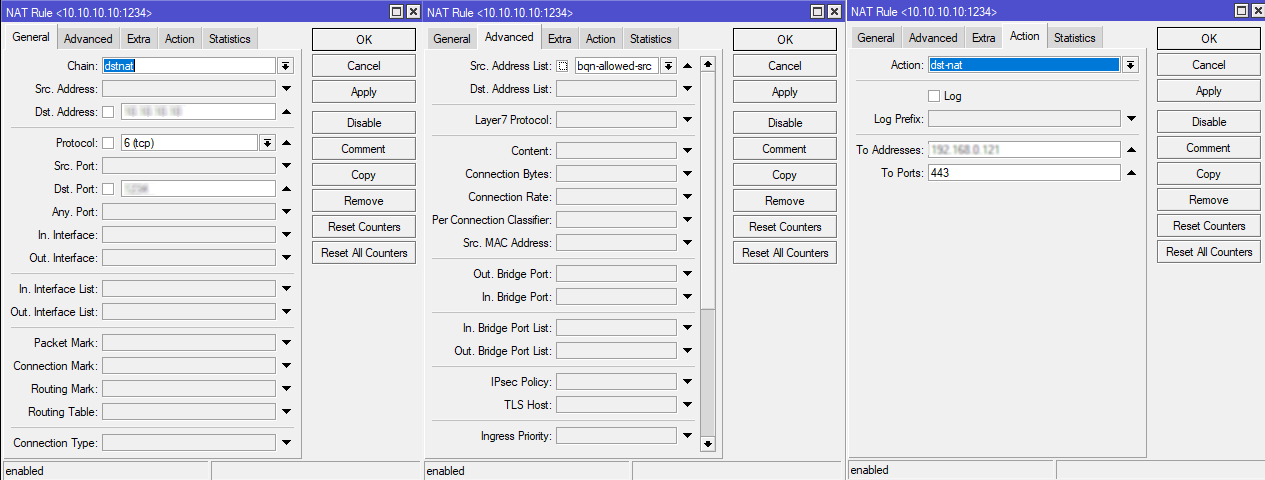
Lorem ipsum dolor sit amet, consectetur adipiscing elit. Suspendisse varius enim in eros elementum tristique. Duis cursus, mi quis viverra ornare, eros dolor interdum nulla, ut commodo diam libero vitae erat. Aenean faucibus nibh et justo cursus id rutrum lorem imperdiet. Nunc ut sem vitae risus tristique posuere.
Lorem ipsum dolor sit amet, consectetur adipiscing elit. Suspendisse varius enim in eros elementum tristique. Duis cursus, mi quis viverra ornare, eros dolor interdum nulla, ut commodo diam libero vitae erat. Aenean faucibus nibh et justo cursus id rutrum lorem imperdiet. Nunc ut sem vitae risus tristique posuere.
Lorem ipsum dolor sit amet, consectetur adipiscing elit. Suspendisse varius enim in eros elementum tristique. Duis cursus, mi quis viverra ornare, eros dolor interdum nulla, ut commodo diam libero vitae erat. Aenean faucibus nibh et justo cursus id rutrum lorem imperdiet. Nunc ut sem vitae risus tristique posuere.
